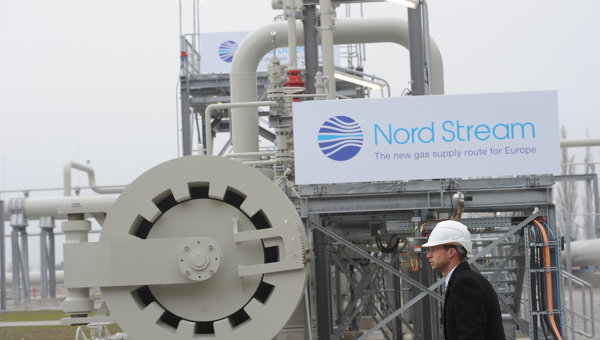
The Gazelle Pipeline: Czech Segment on New Russian Gas Route to Western Europe
Publication: Eurasia Daily Monitor Volume: 11 Issue: 23
By:

Gazelle, the new gas transit pipeline in the Czech Republic, completed in 2013, is conceived to function as a prolongation of the Gazprom-controlled Nord Stream and OPAL pipelines into continental Europe; albeit free of Gazprom’s control on the Czech Republic’s territory.
The Gazelle pipeline is dedicated to transiting 30 billion cubic meters (bcm) of Russian gas annually to points west. That gas is to be delivered by Nord Stream on the Baltic seabed, onward by OPAL via northern Germany into Gazelle on Czech territory, thence into southern Germany and farther afield into Europe. Furthermore, Gazelle forms the third segment in the gigantic arc of pipelines—Nord Stream–OPAL–Gazelle—by which Gazprom circumvents Ukraine’s gas transit system, reaching West-Central Europe from the north (see below).
The Gazelle pipeline holds strategic significance in Central Europe thanks to that concept, piggybacking on Gazprom’s export strategies. Technically, Gazelle is key to connecting several national gas market areas or gas-trading regions and pipeline corridors (in the sense of the European Commission’s concept of Entry-Exit zones) with each other. The Commission may be pleased by this interconnectivity achievement, and the Czech Republic is pleased for the chance to become a gas hub country.
However, the interconnectivity and hub in this case are mainly for Russian gas (most of it directly delivered, some indirectly). This is simply because the lion’s share of natural gas in the Czech market and in those interconnected markets continues to be the gas of Russian provenance. Gazprom now offers more of the same to Gazelle via OPAL, the Gazprom-controlled 35-bcm pipeline in Germany (see EDM, January 31, February 4).
With its 30 bcm in annual capacity, Gazelle runs 165 kilometers in western Bohemia, anchored by two interconnection points on the border with Germany in the north and in the south. Gazelle takes Russian gas at the northern end from the OPAL pipeline (Olbernhau-Brandov interconnection) and delivers the same gas at Gazelle’s southern end (Rozvadov-Waidhaus interconnection) into the MEGAL pipeline that runs across Germany, from Bavaria to eastern France. The full volume originates in the Nord Stream pipeline from Russia. Gazprom is defined as the owner of the gas in transit on Czech territory from Gazelle’s entry point to its exit point.
Gazelle’s status is that of an interconnector pipeline, with a dedicated one-directional gas flow (as above). Although it is operated by the Czech Republic’s gas transmission system operator, Gazelle functions in a distinct regime, as a transit pipeline serving external clients. Nevertheless, Gazelle links up at several points with the national transmission grid, and has the technical capacity to provide bi-directional flows. These features enable the Gazelle pipeline to supply the Czech Republic in emergency situations. While still under construction, Gazelle was exempted from third-party access for 23 years (the stated investment ammortization period) by the European Commission.
The company NET4GAS, a subsidiary of RWE (Rheinisch-Westfaelische Elektrizitaetswerke), alone financed the construction of Gazelle from scratch. The Munich- and Innsbruck-based ILF Consulting Engineers executed the design and construction. RWE and its subsidiary NET4GAS owned and operated the Czech Republic’s gas transmission system until 2013. In that year (even as Gazelle came on line), however, RWE sold NET4GAS to an investors’ consortium, comprised of the Munich-based Allianz Capital Partners (global-scale insurance firm) and Canada-based Borealis Infrastructure (investment arm of a giant pension fund). Allianz and Borealis hold 50 percent of the shares each. NET4GAS remains the Czech transmission system’s, as well as Gazelle’s, exclusive operator (NET4GAS press releases, January 14, October 24, December 2, 2013).
The Czech Republic’s pre-existing two trunklines are traditionally sourced with Russian gas from the Ukraine-Slovakia transit corridor. One Czech trunkline runs from the Slovak-Czech border (Lanzhot) to the Czech-German border (Hora Sv. Kateriny–Deutschneudorf interconnection). Thus, Russian gas delivered via Ukraine flows into Slovakia, the Czech Republic and Germany. Conversely, some gas volumes enter from Germany into the Czech Republic’s trunkline. Such volumes originate in northern Germany’s spot market and are mainly of Russian and Norwegian provenance.
The Gazelle pipeline, targeting third markets, does not increase the level of Czech dependence on Russian natural gas. This could happen in the future, subject to commercial arrangements with Gazprom in its role as Gazelle’s sole shipper. Czech dependence on Russian gas (counting direct and indirect deliveries) stands at two thirds of the country’s annual consumption and import (consumption hovered around 9 bcm annually in recent years, with a slight growth tendency—www.ec.europa.eu/energy/infrastructure/exemptions/doc/exemption_decisions.pdf, last updated December 12, 2013).
From one Czech perspective (reflected by President Milos Zeman last October at the site—NET4GAS press release, October 24), the Gazelle pipeline can provide the country with some emergency supplies in the event of Russia interrupting its gas supplies to Ukraine, and implicitly to EU countries via Ukraine.
Meanwhile, Russia is re-routing growing gas export volumes away from the Ukrainian transit system and into Nord Stream. (This equally hurts Slovakia’s vast transit system, the direct continuation of Ukraine’s pipelines to Europe). Moscow’s intent is to forward those volumes from Nord Stream through the OPAL and Gazelle pipelines into the European heartland, instead of using the much shorter Ukrainian-Slovakian transit route to Europe (see above).
In that case Gazprom, or European importers, or both sides would presumably have to subsidize those transportation costs. According to calculations by Mikhail Korchemkin of the US-based East European Gas Analysis, transportation costs for 12 bcm of Russian gas through Nord Stream, OPAL and Gazelle to the Czech-German border at Waidhaus (see above) were as much as four times more expensive in 2013, compared with the costs of transporting that same gas volume via Ukraine and Slovakia to the Waidhaus destination (naturalgaseurope.com, accessed February 4, 2014).




